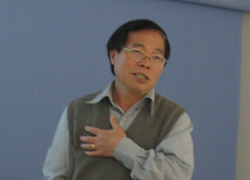Room 4.1F03, Telematics Department, Torres Quevedo Building, University Carlos III of Madrid, Avda. Universidad, 30, 28911 Leganes – Madrid
Abstract:
The talk consists of two parts. The first part will present an overview on the current research activities of iNEXT (Centre for Innovation in IT applications and Services) at the University of Technology, Sydney. This includes a brief description of our Sensor Grid for Assistive Healthcare project.
The second part will present a new research project in the area of optimising energy consumption in wireless sensor network applications. Most wireless sensor networks operate with very limited energy sources-their batteries, and hence their usefulness in real life applications is severely constrained. The challenging issue is how to optimize the use of their energy in order to lengthen their lives for wider classes of application. Unlike most current researches that focus on a single energy constituent of WSNs independent from and regardless of other constituents, our research focuses on the overall energy consumption as a performance measure and the talk presents a Hierarchy Energy Driven Architecture (HEDA) for minimizing the total energy consumption of a WSN. As the research is still in its early stage, many important issues are being explored. You are welcome to collaborate with us on this investigation.
Who is Doan B. Hoang?
Doan B. Hoang is a currently a Visiting Professor in Ingenieria Telematica Department at UC3M. He is a Professor in the School of Computing and Communications, Faculty of Engineering and Information Technology, the University of Technology, Sydney (UTS). Before joining UTS, he was with Basser Department of Computer Science, SydneyUniversity. He also held various visiting positions: Visiting Professorships at the University of California, Berkeley; Nortel Networks Technology Centre in Santa Clara, USA; the University of Waterloo, Canada; Massey University, New Zealand; and Nanyang Technological University, Singapore. He is a Co-director of the UTS Centre for Innovation in IT Services and Applications (iNEXT).
His industrial experiences include: Senior architect, Nortel Networks; Voice/Data communications R&D manager, Fujitsu Australia Limited; Radio-communications Engineer, Telecom Australia. His research interests include Next Generation Networks, Network-Oriented Service Architectures, Collaborative Grid Computing, Wireless Sensor Networks and e-Health. He is currently leading research into establishing an innovation culture, reducing the cost of healthcare system through advanced technologies and assistive health Grid, and innovative use of the Broadband Internet. He has published over 150 papers in peer reviewed journals, conferences and workshops in his field. He serves as a Technical Program Chair for IEEE Healthcom 2009 in Sydney.

The conference will be conducted in English

